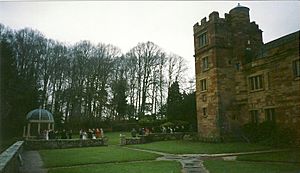Dalston Hall facts for kids
Dalston Hall is a special old house in Dalston, Cumbria, England. It's like a strong castle and a fancy country home all in one! It's so important that it's listed as a Grade II* building, which means it's a very significant historic place.
Building a Strong Home: Dalston Hall's Beginnings
This amazing house was first built around the year 1500 by a man named John Dalston. He wanted a strong home, so he included a Peel tower in its design. A Peel tower was a tall, strong tower built to protect families from attacks, especially in border areas. The house also had a large "baronial hall," which was a big room used for gatherings and feasts.
An old message carved into the building says, "JOHN DALLSTON ELSABET MI WYF MAD YS BYLDYNG." This tells us that John Dalston and his wife, Elizabeth, built this home together. Later, in 1556, a new part was added to the west side of the house.
The Dalston Family's Legacy
The Dalston family lived in Dalston Hall for many, many years. Several family members became important leaders in the area. Some were "sheriffs," who were like the main law enforcement officers of the county. Others became "MPs," which stands for Members of Parliament. They were chosen to represent their area in the country's government.
During a time called the Siege of Carlisle (1645) in 1645, the house was taken over. Sir George Dalston, who lived there at the time, had to leave. A general named David Leslie used Dalston Hall as his headquarters during this conflict.
New Owners and Modern Changes
Over the centuries, Dalston Hall changed hands a few times. In 1761, a businessman from London named Monkhouse Davison bought the house. He owned it for 32 years until he passed away.
Later, in 1897, Edmund Wright Stead bought Dalston Hall. He owned a company that printed patterns on fabric, called "calico printers." Mr. Stead hired an architect named C.J. Ferguson to update the front of the house in 1899, using beautiful red sandstone.
More recently, Dalston Hall has been used in different ways. For a while, it was a place where young people could get training for jobs. Then, in 1971, it was turned into the lovely country house hotel it is today. People can now stay there and enjoy its rich history.


